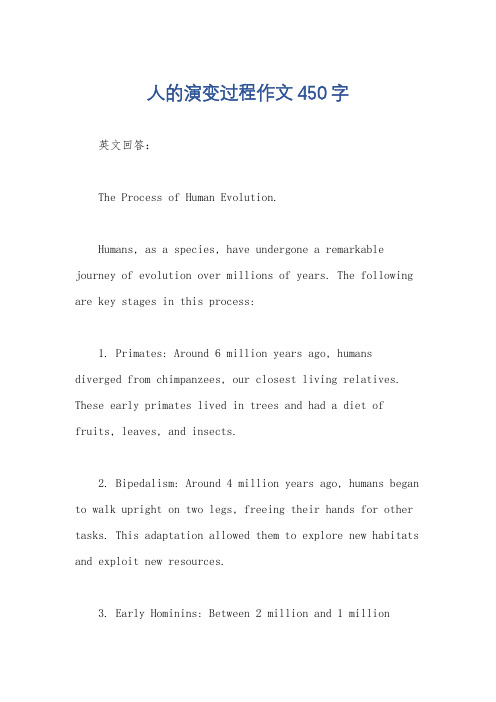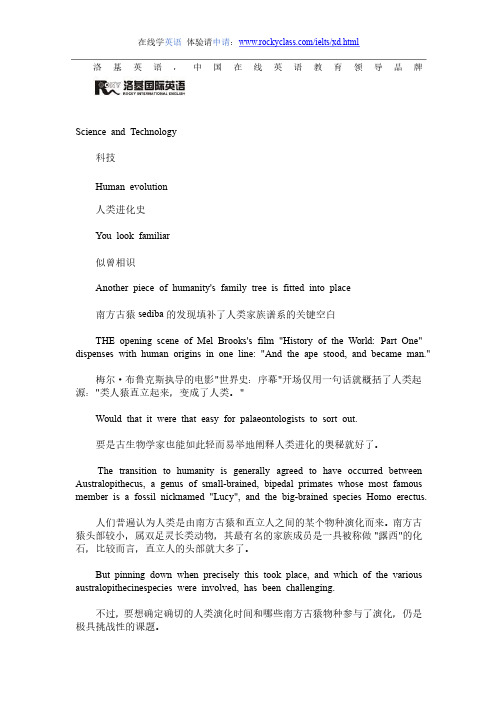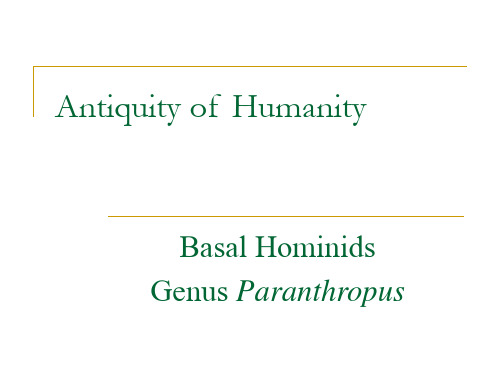人类进化史【英文精品】Human Evolution
人类是如何进化的英文作文

人类是如何进化的英文作文英文:Humans have evolved over millions of years through a process of natural selection and adaptation. The process of evolution can be traced back to our earliest ancestors, who were primitive hominids that lived in Africa around 6million years ago. These early hominids gradually evolved into the various species of the Homo genus, including Homo habilis, Homo erectus, and eventually Homo sapiens, whichis the species that we belong to.One of the key factors that drove human evolution wasthe ability to adapt to changing environments. For example, early humans had to develop the ability to walk upright in order to survive on the African savannas. This adaptation allowed them to see over tall grass and cover long distances, which was crucial for hunting and gathering food. Over time, this ability to walk upright became a defining characteristic of the human species.Another important factor in human evolution was the development of complex social structures. Early humanslived in small groups and relied on cooperation and communication to survive. This led to the development of language, which allowed humans to share knowledge and coordinate activities. The ability to work together and share information gave humans a significant advantage over other species, and allowed them to thrive in a wide range of environments.As humans continued to evolve, they also developed advanced tools and technology, which further enhanced their ability to adapt and survive. For example, the development of fire allowed early humans to cook food, which made it easier to digest and provided more energy. This in turn led to changes in the structure of the human jaw and teeth, as they were no longer needed to process raw, tough foods.Overall, human evolution has been a complex and ongoing process, driven by a combination of biological, social, and technological factors. Our ability to adapt, communicate,and cooperate has been crucial to our success as a species, and continues to shape our evolution today.中文:人类经过数百万年的自然选择和适应过程逐渐进化而来。
人的演变过程作文450字

人的演变过程作文450字英文回答:The Process of Human Evolution.Humans, as a species, have undergone a remarkable journey of evolution over millions of years. The following are key stages in this process:1. Primates: Around 6 million years ago, humans diverged from chimpanzees, our closest living relatives. These early primates lived in trees and had a diet of fruits, leaves, and insects.2. Bipedalism: Around 4 million years ago, humans began to walk upright on two legs, freeing their hands for other tasks. This adaptation allowed them to explore new habitats and exploit new resources.3. Early Hominins: Between 2 million and 1 millionyears ago, hominins such as Homo habilis and Homo erectus emerged. These species had larger brains, used tools, and had a more complex social structure.4. Homo Neanderthalensis: Around 400,000 years ago, Homo neanderthalensis appeared. They were robust, cold-adapted humans who inhabited Europe and parts of Asia. Neanderthals interacted with early humans and contributed to the genetic diversity of modern humans.5. Homo sapiens: Around 300,000 years ago, Homo sapiens evolved in Africa. These were the first anatomically modern humans, possessing a fully developed brain and language capabilities. They spread throughout the world, eventually replacing other hominin species.6. Agriculture and Civilization: Around 10,000 years ago, humans began to develop agriculture, which led to settled communities and the rise of civilization. This transformative shift in lifestyle had profound implications for human evolution.7. Modern Humans: Over the past few thousand years, humans have continued to evolve, albeit at a slower pace. This evolution has been driven by factors such as natural selection, genetic drift, and cultural adaptation. Modern humans are highly adaptable and have developed a vast array of technologies and social structures.中文回答:人类进化过程。
外刊阅读冲刺练习:人类进化史似曾相识

洛基英语,中国在线英语教育领导品牌Science and Technology 科技科技Human evolution 人类进化史人类进化史You look familiar 似曾相识似曾相识Another piece of humanity's family tree is fitted into place 南方古猿sediba 的发现填补了人类家族谱系的关键空白的发现填补了人类家族谱系的关键空白THE THE opening opening opening scene scene scene of of of Mel Mel Mel Brooks's Brooks's Brooks's film film film "History "History "History of of of the the the World: World: World: Part Part Part One" One" dispenses with human origins in one line: "And the ape stood, and became man." 梅尔·布鲁克斯执导的电影"世界史:序幕"开场仅用一句话就概括了人类起源:"类人猿直立起来,变成了人类。
" Would that it were that easy for palaeontologists to sort out. 要是古生物学家也能如此轻而易举地阐释人类进化的奥秘就好了。
The transition to to humanity humanity is is generally generally agreed to to have have occurred between Australopithecus, Australopithecus, a a a genus genus genus of of of small-brained, small-brained, small-brained, bipedal bipedal bipedal primates primates primates whose whose whose most most most famous famous member is a fossil nicknamed "Lucy", and the big-brained species Homo erectus. 人们普遍认为人类是由南方古猿和直立人之间的某个物种演化而来。
人类的进化史介绍作文

人类的进化史介绍作文英文回答:Human Evolutionary History.Human evolution is a fascinating topic that traces our species' development and adaptation over millions of years. It is a story of survival, innovation, and progress that has shaped who we are today. In this essay, I will explore the key milestones in our evolutionary history.The story of human evolution begins around 6 million years ago in Africa, where our earliest ancestors, known as Australopithecus, roamed the grasslands. These early hominids were bipedal, meaning they walked on two legs, a crucial adaptation that allowed them to free up their hands for other tasks. Over time, they developed larger brains and more sophisticated tools, paving the way for our species' eventual emergence.Around 2.5 million years ago, a new species called Homo habilis appeared. They were the first to use stone tools, a significant advancement that improved their ability to hunt and gather food. This marked the beginning of the Paleolithic era, or the Old Stone Age, which lasted until around 10,000 years ago.The next major milestone in human evolution came with the emergence of Homo erectus, approximately 1.8 million years ago. This species had a larger brain and a more modern body structure, enabling them to migrate out of Africa and spread across Eurasia. They were skilled hunters and gatherers, using fire for cooking and protection against predators.Fast forward to around 200,000 years ago, and we encounter Homo sapiens, our own species. What sets us apart from our predecessors is our capacity for complex language, symbolic thought, and cultural expression. These cognitive abilities allowed us to develop more advanced tools, create art, and engage in social cooperation on a larger scale. It was during this period that we began to form communitiesand develop the foundations of modern society.One of the most significant developments in human evolution occurred approximately 10,000 years ago with the advent of agriculture. This marked the transition from a nomadic lifestyle to settled communities, as people beganto cultivate crops and domesticate animals. The Neolithic era, or the New Stone Age, brought about profound changesin human society, including the rise of permanent settlements, the division of labor, and the development of complex social hierarchies.As time went on, humans continued to innovate and progress. The invention of writing, the discovery of metals, and the development of complex civilizations allcontributed to our species' advancement. Today, we are the dominant species on the planet, with our technological achievements shaping the world around us.中文回答:人类的进化史。
人类起源的变化过程的范文

人类起源的变化过程的范文## Human Evolutionary History: A Journey of Adaptation.Human evolutionary history is a fascinating and complex subject that encompasses millions of years of adaptation and change. The human lineage traces its roots back to the earliest primates, small tree-dwelling animals that livedin the forests of Africa around 60 million years ago.Over time, these primates gradually evolved into bipedal creatures that could walk upright. This freed up their hands for other tasks, such as carrying food and tools. The development of larger brains and more complex social structures allowed humans to adapt to a wide range of environments and become the dominant species on the planet.The evolution of humans is a continuous process, and we are still adapting to our environment today. As we learn more about our past, we gain a better understanding ofourselves and our place in the natural world.### Key Stages in Human Evolution.There are a number of key stages in human evolutionthat have shaped our species. These include:The emergence of bipedalism (walking upright): This occurred around 6 million years ago and allowed humans to move more efficiently and cover longer distances.The development of larger brains: The human brain has grown significantly in size over the past few million years. This has allowed us to develop more complex cognitive abilities, such as language, problem-solving, and abstract thought.The evolution of social structures: Humans are highly social creatures, and we have evolved to live in complex social groups. This has allowed us to cooperate with each other and share knowledge and resources.The development of technology: Humans have a long history of using tools and technology to adapt to our environment. This has allowed us to survive in a wide range of climates and habitats.### The Future of Human Evolution.The future of human evolution is uncertain, but it is likely that we will continue to adapt to our changing environment. As we face new challenges, such as climate change and resource depletion, we will need to find new ways to survive and thrive.One possible future for human evolution is that we will become more technologically advanced. We may develop new technologies that allow us to live in space or on other planets. We may also develop new ways to enhance our intelligence and physical abilities.Another possible future is that we will become more closely connected to the natural world. We may develop new ways to live in harmony with the environment and to protectthe planet for future generations.### Conclusion.Human evolution is a story of adaptation and change. Over millions of years, we have evolved from small tree-dwelling animals into the dominant species on the planet.As we continue to face new challenges, we will need toadapt and evolve in order to survive and thrive.## 人类进化史,一部适应与变化的征程。
人类的发展历程的英语作文

人类的发展历程的英语作文The development of human beings has been a long and complex journey. From the early days of primitive societies to the modern era of technology and globalization, humans have undergone significant changes in their way of life, social organization, and cultural practices.In the beginning, humans were hunter-gatherers, relying on the land and natural resources to survive. They lived in small, nomadic groups, constantly on the move in search of food and shelter. Over time, they developed tools and techniques to improve their hunting and gathering skills, paving the way for the development of agriculture and settled communities.As human societies became more settled, they began to form complex social structures and systems of governance. This led to the rise of civilizations, with cities, laws, and organized religions. The development of writing and record-keeping allowed for the accumulation of knowledgeand the spread of ideas across vast distances.The industrial revolution marked a significant turning point in human history, as it brought about rapid advancements in technology, transportation, and communication. This led to urbanization and the rise of modern nation-states, as well as significant changes in the way people lived and worked.In recent decades, the digital revolution has transformed the way humans interact and communicate. The internet and social media have connected people across the globe, breaking down barriers of time and space. This has led to unprecedented levels of cultural exchange and the spread of ideas, as well as new challenges andopportunities for human development.Today, humans continue to grapple with pressing issues such as climate change, inequality, and political instability. The future of human development will depend on our ability to address these challenges and work together to create a more sustainable and equitable world for all.。
人类的演化过程的英语作文

人类的演化过程的英语作文The Grand Tapestry of Human Evolution: A Journey Through Time and Adaptation.In the vast tapestry of life, the evolution of humans stands as a captivating narrative of adaptation, resilience, and the relentless pursuit of survival. This extraordinary journey began millions of years ago, with humble beginnings that gradually shaped the complexities of our species.The Origins: Primate Ancestry.Around 6-7 million years ago, in the forested landscapes of Africa, a group of primates embarked on a fateful evolutionary path that would lead to the emergenceof humans. These early primates, known as hominins, possessed a unique combination of traits that set themapart from their kin. They were bipedal, freeing theirhands for tool use, and their brains were undergoing a remarkable expansion.One of the earliest known hominin species is Ardipithecus ramidus, who lived approximately 4.4 million years ago. With its long, grasping toes and the ability to walk upright, Ardipithecus represented a pivotal transition in human evolution. Over time, other hominin species emerged, including Australopithecus afarensis (Lucy) and Australopithecus africanus, who possessed increasingly human-like features.The Genus Homo: The Birth of Our Lineage.Around 2.5 million years ago, a new chapter in human evolution unfolded with the emergence of the genus Homo. Homo habilis, meaning "handy man," was one of the earliest members of this lineage. With larger brains and more advanced toolmaking abilities, Homo habilis embarked on a path of rapid cultural and technological development.The subsequent species, Homo erectus, was a highly successful and widespread hominin that roamed across Asia and Africa. With its upright posture, robust physique, andthe ability to control fire, Homo erectus played a pivotal role in human colonization beyond Africa.Homo Sapiens: The Dawn of Modernity.Approximately 200,000 years ago, the most recentchapter in human evolution commenced with the emergence of Homo sapiens, our own species. Archaic Homo sapiens, suchas Neanderthals and Denisovans, coexisted with us for a time, but eventually, Homo sapiens prevailed.With superior cognitive abilities, advanced language skills, and the capacity for complex social organization, Homo sapiens embarked on a remarkable journey of cultural innovation, technological advancement, and global expansion. We developed sophisticated tools, mastered agriculture, and established complex societies that laid the foundation for human civilization.The Enduring Legacy: Adaptation and Resilience.Throughout our evolutionary history, humans have facedcountless challenges and environmental pressures. From the harsh conditions of the Ice Ages to the complexities of modern society, our species has demonstrated an extraordinary capacity for adaptation and resilience.Genetic diversity, cultural innovation, and technological ingenuity have been key drivers of our success. Through natural selection, our populations have evolved to thrive in a wide range of environments. Our ability to learn, collaborate, and modify our surroundings has allowed us to overcome obstacles and shape our own destiny.As we continue to unravel the mysteries of human evolution, we gain a deeper understanding of our origins, the forces that have shaped our species, and the potential for our future. The grand tapestry of human evolution is a testament to the power of adaptation, the resilience of life, and the boundless potential of the human spirit.。
人类早期进化【英文】Early Human Evolution

Sahelanthropus tchadensis
Ardipithecus ramidus
This species was named in September 1994 (White et al. 1994; Wood 1994). It was originally dated at 4.4 million years, but has since been discovered to far back as 5.8 million years. Most remains are skull fragments. Indirect evidence suggests that it was possibly bipedal, and that some individuals were about 122 cm (4'0") tall. The teeth are intermediate between those of earlier apes and A. afarensis, but one baby tooth is very primitive, resembling a chimpanzee tooth more than any other known hominid tooth. Other fossils found with ramidus indicate that it may have been a forest dweller. This may cause revision of current theories about why hominids became bipedal, which often link bipedalism with a move to a savannah environment.
- 1、下载文档前请自行甄别文档内容的完整性,平台不提供额外的编辑、内容补充、找答案等附加服务。
- 2、"仅部分预览"的文档,不可在线预览部分如存在完整性等问题,可反馈申请退款(可完整预览的文档不适用该条件!)。
- 3、如文档侵犯您的权益,请联系客服反馈,我们会尽快为您处理(人工客服工作时间:9:00-18:30)。
“A Brief Overview”
The Argument in Syllogisms
Western Religion
Premise 1 - God created humanity. Premise 2 - Humanity did not evolve. Conclusion 3 - Therefore, there will be no evidence of human evolution.
Do the same laws of evolution apply to human beings?
In a new book, documentary, and promotional Web site, paleontologist Jorn Hurum, who led the team that analyzed the 47-million-year-old fossil seen above, suggests Ida is a critical missinglink species in primate evolution. The fossil, he says, bridges the evolutionary split between higher primates such as monkeys, apes, and humans and their more distant relatives such as lemurs. "This is the first link to all humans," Hurum, of the Natural History Museum in Oslo, Norway, said in a statement. Ida represents "the closest thing we can get to a direct ancestor."
Material found deepest is oldest
Material found is same age as other material in same layer
Scientific Dating of Fossils
Modern humans originated in Africa
There was one founding population It began 170,000 years ago They migrated to other parts of the world to replace other hominids
Carbon dating is proven accurate back to 50,000 years Uranium isotope dating is proven accurate back to 500,000 years Potassium to argon dating is proven accurate back to 5 billion years
Ardipithicus
4.4 million years ago
Science Limits Itself to:
The physical evidence Possible theories that explain the patterns of physical evidence New improved theories as more physical evidence is found No theories that cannot be supported by physical evidence
Geological Time & Human Development
Байду номын сангаас
Homo Sapien
100-200,000 years old
Mitochondrial DNA Dating
Five Principles of Evolution
Variation has a genetic origin due to mutation and recombination Natural selection and gene flow causes changes in gene frequency in populations Adaptation is genetically based and leads to changes in population over time Species formation evolves through reproductive isolation Genetic changes through natural selection lead to new species
Homo Habilis
1.9 million years old
Australopithecine Afarenis
3.2 million years old
Science
Premise 1 - All life forms on earth go through the process of evolution.
Premise 2 - Humanity is a life form on earth. Conclusion 3 - Therefore, there will be evidence of human evolution.
Life Cycle of Stars
Death of a Star
Age of the Earth – 5 billion
All life comes from the same sources…
